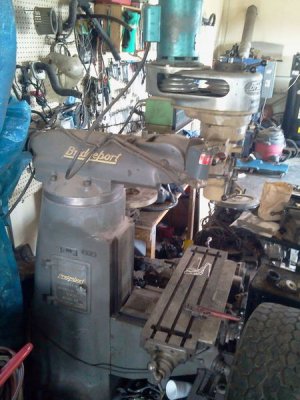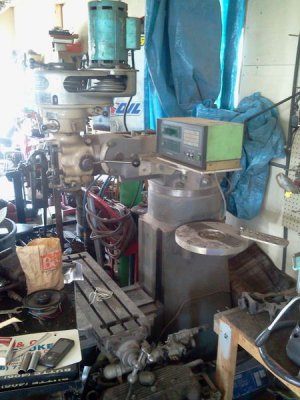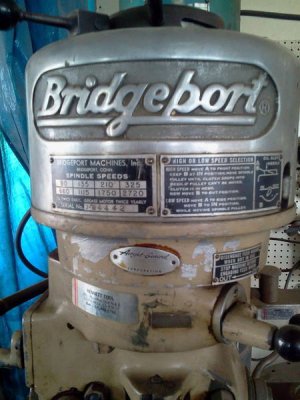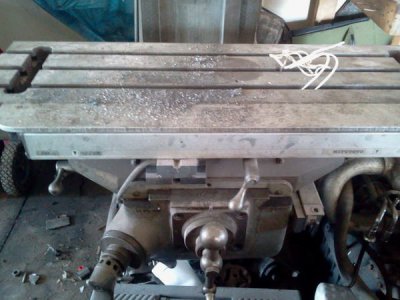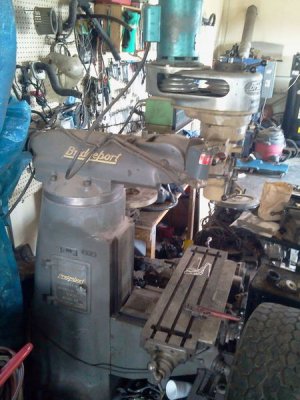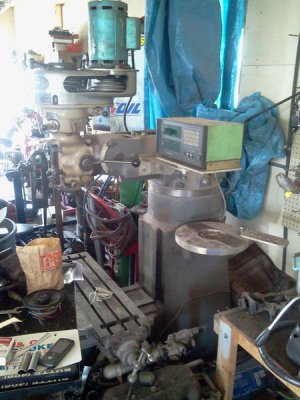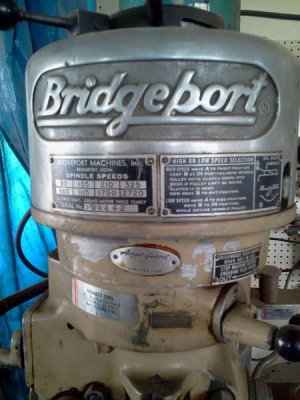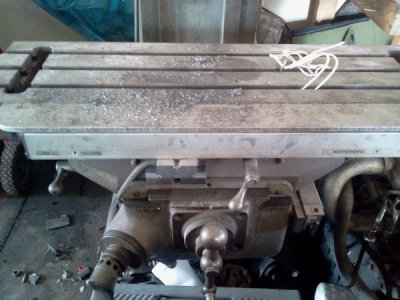- Joined
- Jul 1, 2012
- Messages
- 1,356
I have been rebuilding Bridgeports for over 40 years. I am a professional Machine Rebuilder and Millwright.
You sound like your an experienced machinist mate and can do this yourself. Safety first though!
You have a 36" table machine. The first thing I would do is clean the ways under the knee and crank the knee down to the bottom of the ways. Then clean the ways of the over arm ram and front of top of knee, crank the saddle out as far as it will go and loosen the 2 ram locks and move it out so when you swing the head around and motor down it doesn't hit the column.
Loosen the 4 - 3/4" nuts that hold the head on and use a 3/4 socket and ratchet and crank the head around and have a friend hold it as it moves around as the worm and worm rack are sometimes worn and will strip if you don't support it as it rolls around. When the head is 180 deg's. flipped over tighten the 4 nuts (Some only have 3 as the other guy said, but those are old machines) The book the one guy talks about dismantling the machine looks like a copy of the original Bridgeport book and looks like a good deal, The price the author charges to rebuild the machine is super high in my opinion.
If you look at the top of the ram there is a 1/2 / 13 tapped hole where you can put in an eye bolt (not a cheap one you buy at Home Depot, you know this from your days in the Navy) and screw it in all the way with 3 or 4 flat washers under the eye. Before you leave the shop your loading it at, slide in a 1' Heavy Duty Nylon strap or hardened chain with cleavace and lift the machine with your friends forklift. You can carefully move the ram in and out to get the center of gravity right. You may have to move the saddle in too. when you find it, set it back on the ground. Then put a 2 x 4 on top of the centered table and slowly crank the knee up to snug the board just to help support machine components and lock the knee, table and saddle. Some guys also put boards and tapered shims under the knee.
Load it on your trailer and use 2" HD nylon straps to hold it down, one over the ram and one over the knee. Many times we nail 2 x 4's around the base if the trailer bed is wood or you can set the machine on a 1" piece of plywood. If I were you I would look up in your rafters in your barn and see how solid they are, as the ones in my bard are rated for hay in the loft. If you can do it lay a oak 4 x 4 x say 10' long up there and rent a chain hoist or buy one. a one ton should be enough and chain the hoist to the 4 x 4. Then back your trailer inside the barn and lift up the machine and drive the trailer out of barn and lower the machine. The idea using the pipe is ok too, but it could get away on you moving it down the ramp. If it does, do not try to stop it as your bones break easier then the cast iron. You know this from your Navy days. Or use your engine hoist if it is heavy enough to do it.
If you were not so experienced I would also hire a professional as they could probably spend 10 minutes unloading it. Better safe then sorry I always say. If you need any more help call me. 651 338 8141. Richard King
PS: If you want to re-scrape the machine sometime, lets do a scraping seminar in your shop and invite all your buddies and the guys on here, it would be fun.
You sound like your an experienced machinist mate and can do this yourself. Safety first though!
You have a 36" table machine. The first thing I would do is clean the ways under the knee and crank the knee down to the bottom of the ways. Then clean the ways of the over arm ram and front of top of knee, crank the saddle out as far as it will go and loosen the 2 ram locks and move it out so when you swing the head around and motor down it doesn't hit the column.
Loosen the 4 - 3/4" nuts that hold the head on and use a 3/4 socket and ratchet and crank the head around and have a friend hold it as it moves around as the worm and worm rack are sometimes worn and will strip if you don't support it as it rolls around. When the head is 180 deg's. flipped over tighten the 4 nuts (Some only have 3 as the other guy said, but those are old machines) The book the one guy talks about dismantling the machine looks like a copy of the original Bridgeport book and looks like a good deal, The price the author charges to rebuild the machine is super high in my opinion.
If you look at the top of the ram there is a 1/2 / 13 tapped hole where you can put in an eye bolt (not a cheap one you buy at Home Depot, you know this from your days in the Navy) and screw it in all the way with 3 or 4 flat washers under the eye. Before you leave the shop your loading it at, slide in a 1' Heavy Duty Nylon strap or hardened chain with cleavace and lift the machine with your friends forklift. You can carefully move the ram in and out to get the center of gravity right. You may have to move the saddle in too. when you find it, set it back on the ground. Then put a 2 x 4 on top of the centered table and slowly crank the knee up to snug the board just to help support machine components and lock the knee, table and saddle. Some guys also put boards and tapered shims under the knee.
Load it on your trailer and use 2" HD nylon straps to hold it down, one over the ram and one over the knee. Many times we nail 2 x 4's around the base if the trailer bed is wood or you can set the machine on a 1" piece of plywood. If I were you I would look up in your rafters in your barn and see how solid they are, as the ones in my bard are rated for hay in the loft. If you can do it lay a oak 4 x 4 x say 10' long up there and rent a chain hoist or buy one. a one ton should be enough and chain the hoist to the 4 x 4. Then back your trailer inside the barn and lift up the machine and drive the trailer out of barn and lower the machine. The idea using the pipe is ok too, but it could get away on you moving it down the ramp. If it does, do not try to stop it as your bones break easier then the cast iron. You know this from your Navy days. Or use your engine hoist if it is heavy enough to do it.
If you were not so experienced I would also hire a professional as they could probably spend 10 minutes unloading it. Better safe then sorry I always say. If you need any more help call me. 651 338 8141. Richard King
PS: If you want to re-scrape the machine sometime, lets do a scraping seminar in your shop and invite all your buddies and the guys on here, it would be fun.


